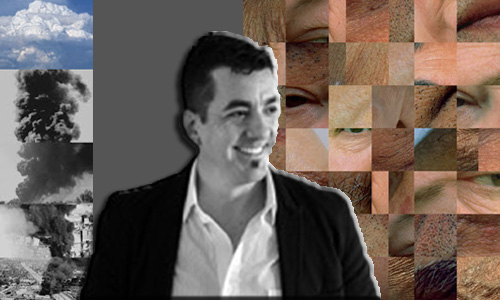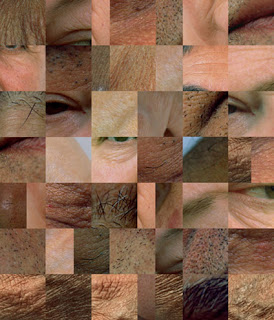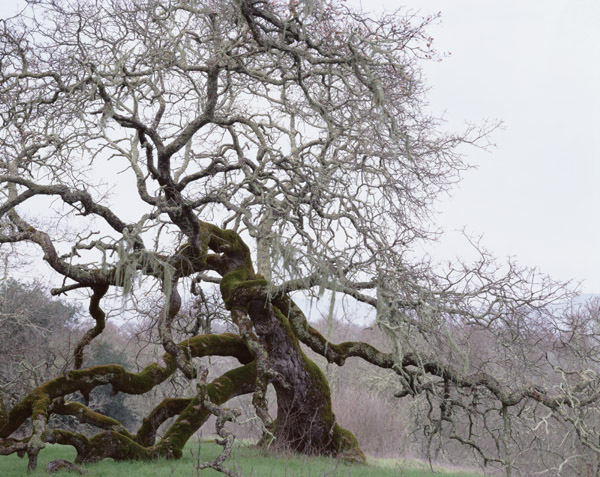Ken Gonzales-Day
- Ken Gonzales-Day
- Selected Pieces
- Richard Pickwoad

Ken Gonzales-Day is a photographer. His works explore humanity in terms of race and the history of photography by presenting some of tragic and cruel history. His work makes us conscious of our past, that of Los Angeles in particular, and reminds people of the struggle and indecencies that people of color have endured. Currently, he is a Professor and Chair of the Art Department at Scripps College. He also has many different works in museum collections around the country including the Getty Museum in Los Angeles, The Museum of Man in San Diego, and The Field Museum in Chicago. His work has also been featured internationally such as in an exhibition at the L'École des beaux-arts in Paris, France.
City in Flames: Series - Everyday Revolution
My Interpretation: This piece I thought to be quite eye grabbing. It starts off with a city on fire and all the progressing pictures appear to be of smoke of different fires taken at different times and then it ends peacefully with white clouds. All the pictures preceding the picture of peaceful clouds are all in black in white. Even though the black clouds of smoke symbolize destruction, there are also clouds that can instill bewilderment and beauty as if to give hope. It also makes me think back to something I’ve heard before about how destruction can lead to creation. An example that comes to mind is controlled forest fires, where the destruction of the forest allows for the creation of new life to flourish.
Behind the picture: In this picture, what Ken Gonzalez-Day has done is combine Los Angeles’ race riots and Los Angeles’ greatest wildfires. What you are seeing is a part of the city on fire due to the riots that were occurring because of the race discrimination that was rampant throughout the country at the time. This work is particular to LA. It starts with a part of the city on fire, and proceeds to other images of clouds of smoke that are taken from wildfires that LA has suffered through. Finally ending with a picture of clouds in the sky. Gonzales-Day, through this piece, reminds people of some the darker sides to LA’s history.

Untitled #94: Series - Dysmorphologies
My Interpretation: This piece is interesting to me because of all the individual pictures of the different portions captured from these people. I think that although individually they are all different pictures of different people with different characteristics at different points in life, there are commonalities. The way everyone gets old is most notable to me here. The way skin wrinkles. But something else I noticed as well is that some of the pictures, in a way, fit together as if they were the same picture. I thought that was interesting because I think that we get lost amongst the differences and forget how similar we all are.
Behind the Picture: This piece is part of a series by Gonzales-Day titled Dysmorphologies. He uses a grid to explore different parts of the body from many different individuals. This is part of a style that through the grid can capture the abstract forms of the human body. Throughout the series, Gonzales-Day focuses on parts of the body that have either been disfigured or altered by means of injury like scars or tattoos or through age like wrinkles.

Run Up: Series - Hang Trees
My interpretation: I chose this piece because the feeling I got from looking at this tree. There was just this feeling of grandness and awe at the beautiful things Mother Nature can create. I see the tree as evoking a sentiment of a sort of freedom because its far-reaching branches seem unrestricted, except by the laws of gravity. But even so, its branches stretch out far from the trunk and the trunk itself stands in a way where it seems like it had the freedom to choose the direction it grew and change directions again. It seems like it grew up and was twisting and turning along the way. Choosing the way it wanted to touch the sky. And from the grandness, it also has this sense of archaic wisdom. This is a free spirited tree that has stood the test of time and survived all that Mother Nature has done to care for it and destroy it. And over all it is just a really cool example of the things mother nature has done.
Behind the Picture: This is a piece by Ken Gonzales-Day in a series of pictures titled Hang Trees. Gonzales-Day went all throughout California and took pictures of different trees from different places in California. Little did I know that the trees that were a part of the Gonzales-Day’s series called Hang Trees was named so because they were literally used to hang people. It shocked me to learn that all these trees throughout California were used to hang people; Native Americans, African Americans, Chinese immigrants, and Latinos. Gonzales-Day began this project when diving into California’s lynching history. This totally changed my perspective on how I viewed the rest of these pieces once I became informed.

I am a student at the University of California Los Angeles. I come from the San Fernando Valley from the small city of Sylmar. Although I’ve grown up on the outskirts of LA, LA has always been apart of my life. UCLA was also part of the LA culture and it was my dream to attend. Having the opportunity to go to my dream school has been amazing. Also, growing up so close to the city, LA was where a majority of things happened and getting my drivers license and attending UCLA allowed me to further get involved with what was going on. It’s been great to gain diverse experiences, to learn everyday, and to know the adventure still continues.



